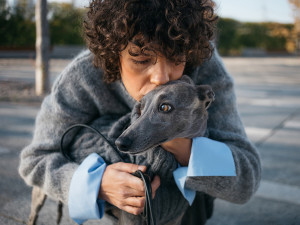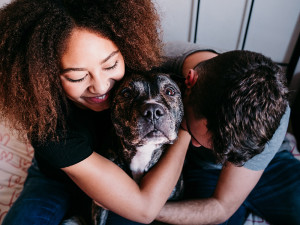These Common Household Noises Are Super Stressful for Dogs, Study Finds
Fireworks and thunderstorms aren’t the only things that make them say, “No, thanks!”

share article
Dog parents often go into a collective panic when a thunderstorm rolls inopens in a new tab or the neighbors light off 4th of July fireworks for three nights in a row. They will sell their souls to protect their pups from any noise that sends them running underneath the bed, but at the same time, some have no clue that many more common household sounds can be upsetting to their dogs as well.
Modern life is noisy, whether the microwave is humming and beeping, the smoke alarm low battery alert is chirping, or the vacuum has come alive. Half the time when I make pancakes, I accidentally test our smoke alarm, and let’s just say the dogs in my home are not fans.
Most sound-related research on dogs focuses on infrequent but (from the dog’s point of view) catastrophic sounds, like gunshots and fireworks. Many everyday sounds that also upset dogs are largely ignored in studies, despite their negative effects on our best friends’ emotional state.
So, what sounds actually scare dogs?
Sudden loud noises are one of the most common causes of fearful behavioropens in a new tab in our dogs, but not enough is known about dogs’ reactions to the range of sounds that frighten them. Fear of sounds can cause anxiety in dogs, and living with either fear or anxiety (or both) can lead to a decreased quality of life and serious welfare concerns.
In a 2021 studyopens in a new tab, researchers discovered high frequency beeping and low frequency continuous sounds such as alarm clocks, plumbing, smoke detectors, cell phone noises, washing machines, dishwashers, vacuum cleaners, and fans can stress dogs out.
They also found that many pet parents underestimate their dogs’ negative emotional responses to such sounds, and often get a chuckle out of their dogs’ reactions.
What do dogs do when they hear loud noises? Bark, obviously.
In this study, researchers surveyed 386 dog parents to learn how their dogs react to common household sounds. The purpose was to find out if dogs react to such sounds with fear, stress, and anxiety. Two-thirds of the people reported that their dogs were not fearful, and 70 percent of them had never sought help for a behavioral problem. However, when asked specifically about whether their dogs were afraid of loud soundsopens in a new tab (fireworks, thunder, gunshots), half said “yes” and half said “no.”
It will come as no surprise to anyone that the most common response to a loud sound was barking, which half of the dog parents reported. (That’s why the “mute” button on Zoom is such a Godsend!) Nearly one-third of people in the survey said their dogs retreated when they heard something. Behaviors associated with more serious stress in dogs, such as trembling, salivating, lip licking, panting, and howling were less common but still prevalent.
Low-frequency sounds cause dogs to jump on you, apparently.
In addition to analyzing dog behavior through surveys, the scientists also examined the behavior of dogs and people in videos and compilations posted online that featured dogs hearing common household sounds. The goal of this part of the study was to figure out how often dogs react to everyday household sounds, what those reactions are, and how people interpret their dogs’ responses.
Researchers searched for such videos on YouTube, using search terms such as “fear,” “afraid,” “fire alarm”, “beeping”, “smoke detector,” and “ vacuumopens in a new tab.” They classified sounds as high-frequency intermittent (translation: beeping or chirping sounds, such as an oven timer or a low-battery warning from a smoke detector) or low-frequency-constant (translation: humming sounds like a microwave or a robot vacuum). The majority of pups in the study trembled when they heard a high-frequency-intermittent sound. But they retreated, lunging and jumping on their parents when the sound was a low-frequency continuous one. The videos also show that high-pitched repeated sounds caused more distress than low frequency continuous ones.
It's also worth taking note of how the pet parents reacted in these videos. In half of them, the pet parents acted like spectators — they did not comment, console, or react to their dog's behavior in any way. Perhaps this is because people were purposely trying to get video of the dog’s behavior to share online. The next most common reaction from these folks was amusement (45 percent of videos), followed by an attempt to analyze the behavior by discussing what was going on and why (26 percent).
Studying video isn’t the best way to get results, but this is compelling evidence.
Studying videos online doesn’t meet normal standards for scientific rigor in terms of random sampling (the authors make this point — nobody’s trying to pull a fast one here). Plus, people don’t typically share the subtle or the barely noticeable dog responses — that usually doesn’t make the most engaging content — so most of the videos show extreme responses.
But the scientists make a compelling case that behaviors indicating fearfulness and anxiety are frequently seen in response to ordinary household noises, not just thunder and fireworks. Another big takeaway: The pet parents in the survey underestimated their dogs’ negative emotional responses to upsetting sounds. Unfortunately, some were also amused by their dogs’ fearful reactions.
My suggestion: Let’s pay more attention to our dogs’ body languageopens in a new tab so it doesn’t take a study to tell us that they hate the sound of the vacuum. And I'm for more compassion when it comes to these very real fears. They don’t laugh at you when their sudden barks make you jump, right? (Well, not that you know of).

Karen B. London, PhD, CAAB, CPDT-KA
Karen B. London, Ph.D., is a Certified Applied Animal Behaviorist and Certified Professional Dog Trainer who specializes in working with dogs with serious behavioral issues, including aggression, and has also trained other animals including cats, birds, snakes, and insects. She writes the animal column for the Arizona Daily Sun and is an Adjunct Professor in the Department of Biological Sciences at Northern Arizona University. She is the author of six books about training and behavior, including her most recent, Treat Everyone Like a Dog: How a Dog Trainer’s World View Can Improve Your Lifeopens in a new tab.
Related articles
![A woman holding her dog close.]() opens in a new tab
opens in a new tabFYI, Your Dog Can’t Stand When You Do These 7 Things
Thanks, they hate it.
- opens in a new tab
How to Tell If Your Dog Is a Hugger—Or Not
Boundaries, folks. Boundaries.
![Couple hugs their merle Boxer]() opens in a new tab
opens in a new tabYour Relationship With Your Dog Matters. Here’s How You Can Improve It
Animal behaviorist Dr. Karen B. London on how to strengthen your pet-parent bond.
![Young woman sitting at desk petting her senior Great Dane]() opens in a new tab
opens in a new tabHow to Speak “Dog”
Lili Chin’s book Doggie Language illustrates how dogs communicate — beyond ear perks and tail wags.
![Woman and dog in lavender field.]() opens in a new tab
opens in a new tabDogs Have Favorite Scents, Study Says—And No, It’s Not Just the Smell of Food
So, go ahead and get that lavender-scented candle.
![Pet parent comforting anxious dog by holding their paw]() opens in a new tab
opens in a new tab8 Tips for Helping an Anxious Dog
Easy ways to calm your pup’s nerves.








